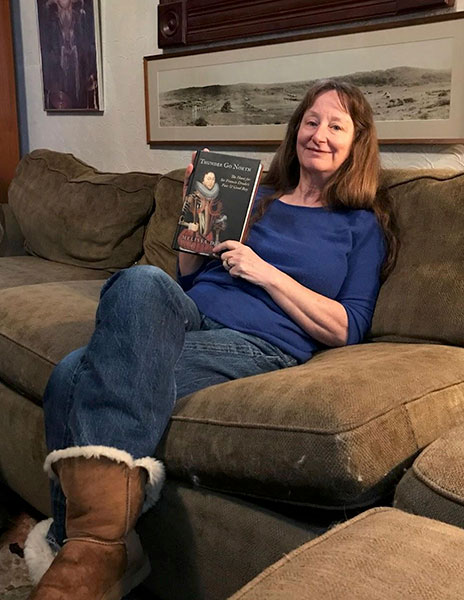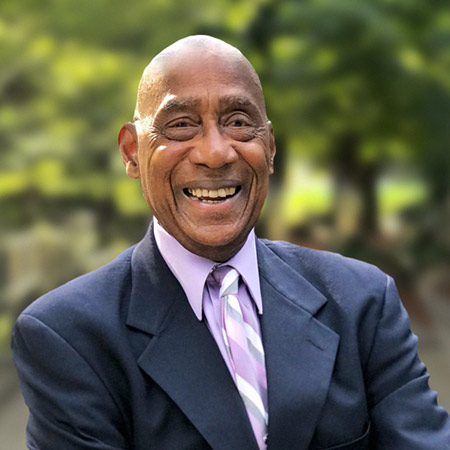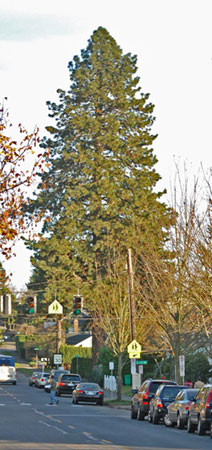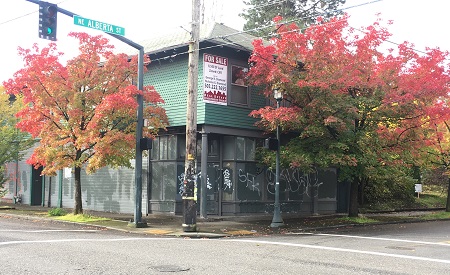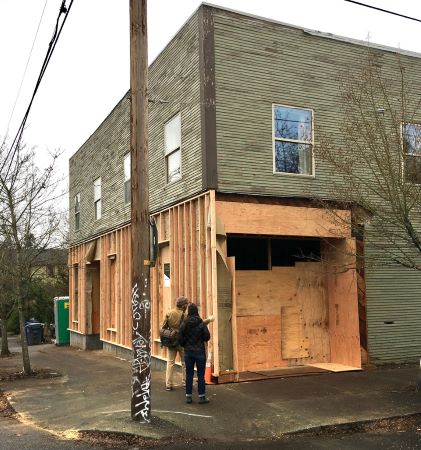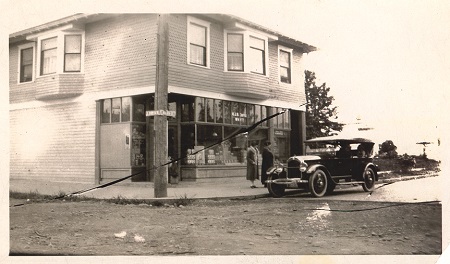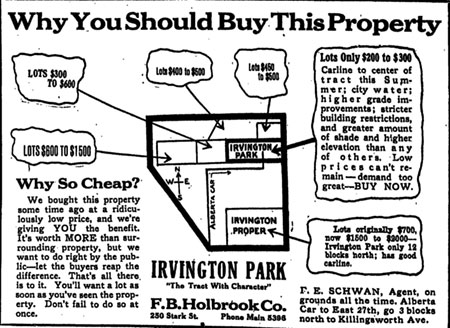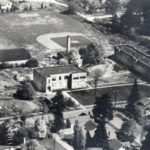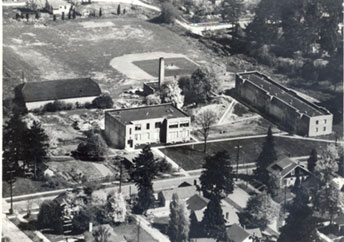By Leo Newman | Contributing Writer

Long before it was a venue for open mics and Star Wars-themed burlesque shows, the Alberta Abbey operated as the Mallory Avenue Christian Church. For exactly a century, the post-war modernist structure, with its unmistakable three story tower and copper spire, has presided over the Albina Neighborhood through waves of urban growth and decay, demographic changes, civil rights struggles and community organizing.
The Underground Church: Pre-War Years (1920-1945)
On May 8th, 1920, the Rodney Avenue Christian Church and the Woodlawn Church voted to merge and construct a new church. The union of 278 congregants purchased a 100’ x 100’ parcel at NE Mallory and Alberta Streets and hired Los Angeles-based Robert H. Orr to build the new church, which they named the Church of Christ at Mallory and Alberta.
Orr drew up plans for an austere Revivalist church, three stories tall on all four sides with Gothic pointed-arch windows and an octagonal sanctuary with domed roof. Such was the style of early 1920s architecture (like Temple Beth Israel on NW Flanders or the Frank Manor House on the Lewis & Clark College campus, both designed by Herman Brookman.) Orr imagined an ornate entryway on the corner, with two sets of steps meeting at two double doors on a raised patio.
The congregation could only afford to build Orr’s plan for the basement, which was completed in May 1925. It contained a large gymnasium with a stage, some classrooms and other ancillary spaces. For twenty years, the church was completely subterranean.
During the Great Depression and the World War II, the construction of churches in Oregon slowed to a halt. However, the war-effort attracted tens of thousands of migrant workers to Portland, many of them African Americans from the South. As the Oregonian reported, “During the past few years, churches of the Northwest have been faced with an unprecedented situation—not enough pews to take care of their congregations.”
The Walter E. Kelly Remodel (1946-1949)
Enters Portland architect Walter E. Kelly, whose other notable contribution to Alberta street is the now Alberta Rose Theater, built in 1926. The church contracted Kelly to design a streamlined and cost-efficient version of Orr’s design which they had purchased twenty years prior. Kelly’s first attempt was an awkward, blocky redesign of Orr’s plan that resembled a modernist auditorium rather than a church but in 1948, Kelly completed a plan for the church as it now stands and construction began later that year.
In modernist style, the church was built with concrete, brick and plaster. Its front-facing facades, with its pitched roof and belltower, are a modernist interpretation of the many small classical churches that sit in the residential blocks surrounding Alberta Street. The church’s minimalistic interior is consistent of modernist (and budget-conscious) post-war churches. The sanctuary’s original flooring was “battleship linoleum,” and its balcony was polished concrete. Kelly’s plans included a place for a fireplace which was never constructed, but is now used as a cafe.
The second floor, which straddles the two-story sanctuary to the east and west, contained pastors’ studies, an assembly hall, two small classrooms and a small caretaker’s apartment. Most of the rooms in the eastern tower were recently consolidated into a single open-floor plan. The northeast tower contains a third floor that presides over the neighborhood.
Demographic Changes to Alberta
The physical landscape of the Albina neighborhoods changed remarkably between 1945 and 1965. In 1948, the Vanport Flood forced some 20,000 African Americans to find housing in highly segregated Portland. Entire African American neighborhoods to the south were razed to the ground to make way for freeways, the Emmanuel Legacy Hospital, high-rises and entertainment complexes.
Meanwhile, White families of means began leaving the neighborhood for the suburbs, while older Whites generally stayed. In 1957, the Fair Housing Act allowed Black Portlanders of means to leave Albina for newer, better neighborhoods. The exodus of wealthier families, White and Black, from Albina, allowed displaced working class Black families, many with small children, to move in.
Minister Robert E. Cochran
Despite maintaining a congregation of mostly older Whites into the 1970s, Mallory Christian Church became a significant patron of community organizations that served the local African American community. In July 1967, Rev. Clifford N. Trout hired recent PSU graduate and NAACP board member Robert E. Cochran as Director of Community Ministry, making Mallory Christian one of the first White churches in Oregon to hire a Black community minister.
A Portland native and the son of a Pullman porter, Cochran studied Sociology at PSU while making waves as a charismatic, impassioned civil rights organizer. Described by the Oregon Advance / TIMES as “one of the busiest men about town,” the 21-year old was elected to the local NAACP’s executive committee as youth chairman in April 1967. (His soon-to-be wife, Sarah Burrus was also elected as committee secretary). In March 1968, Mayor Terry D. Schrunk appointed Cochran to the Model Cities board.
“I’ve been at this church for almost 10 years and for a long time we discussed the matter of community relationship,” Trout said to the Oregonian upon hiring Cochran. “The neighborhood changed from one with mainly older people to one with many children. We felt we should do something to help the changing community. We knew we couldn’t do it with volunteers. We felt we needed a staff person who could devote all of his time to the work.”
The church announced Cochran’s appointment in Oregon Christian, July, 1967, thus: “Mr. Cochran is a negro, and well acquainted with the problems of Portland, especially the Albina area. He is in a very good position to fill the post we have in mind. Although he is not an ordained minister, he has majored in Sociology and has a keen interest and concern on behalf of people.”
Cochran brought life to the church’s forgotten basement gymnasium, leading sports programs for neighborhood children. Much of the support for Cochran’s work came from existing agencies including the Urban League and the Church-Community Action Program (C-CAP).
“I believe that a problem cannot be solved by one organization or by two organizations, but by many organizations –and the entire community, for that matter– working together.” said Cochran to The Oregonian in August 1967.
The YWCA and the People are Beautiful Program
In the mid 1970s, Mallory Christian lent its basement to the YWCA, which provided child-care services and organized several programs for women and girls of all ages, including free classes in everything from calligraphy, yoga, and jazz dance to astrology and personal improvement. Audrey Sanders, a school nurse and community organizer started working with the YWCA in 1974. “The main thing the YWCA did,” she says, “was to teach some of the parents and kids the importance of self-love, self-dignity and self-worth.”
In 1976, Mallory Christian launched the “People Are Beautiful” summer program with Sanders as its director. People Are Beautiful aimed to help its participants, the vast majority of whom were non-white junior high school students, realize their full potential and overcome discrimination and racism. The federal government and Portland Parks Bureau provided funding for the salaries of 14 staff members and daily breakfast and lunch for the children. In 1981, Sanders was among the founders of the Portland Habitat for Humanity Program. In 1990, she was the first ever recipient of the Portland YWCA’s “Founder’s Award.”
In the early 1990s William “Willie” Stoudamire served as director of the People Are Beautiful Program. A PSU basketball star, Stoudamire founded the Night Court Basketball League, which aimed to give gang-affected youth a safe, supervised place to be at night. In 1991, Mallory Christian lent its basement to Oregon Outreach Inc., a nonprofit alternative education program that served juveniles convicted of minor offenses. The program allowed these youth to report to the church for up to two weeks instead of serving time in jail.
Mergers and Closure
In the late 1990s, the wave of gentrification along Alberta Street pushed its African American community further east. In 2000, Mallory Christian merged with the Neighborhood Church of God and eventually disbanded entirely in 2004. The church was rented for brief periods to a short string of congregations until it was purchased by the Alberta Abbey Fellowship in 2012.
Leo Newman is a paralegal and writer based in NE Portland. Trained as a historian, he enjoys exploring the history of Portland and the Pacific Northwest.


